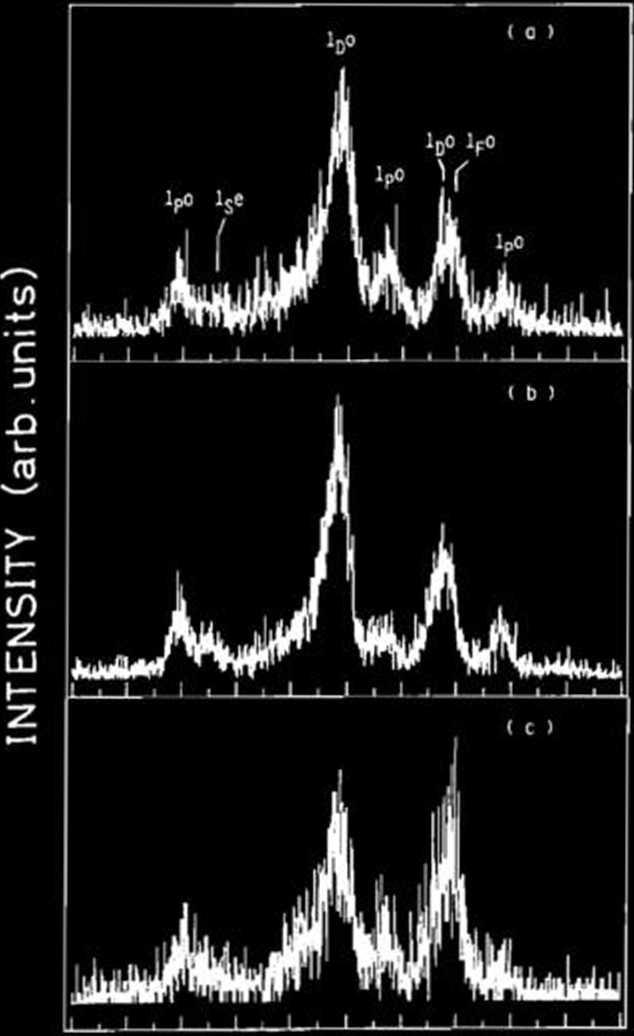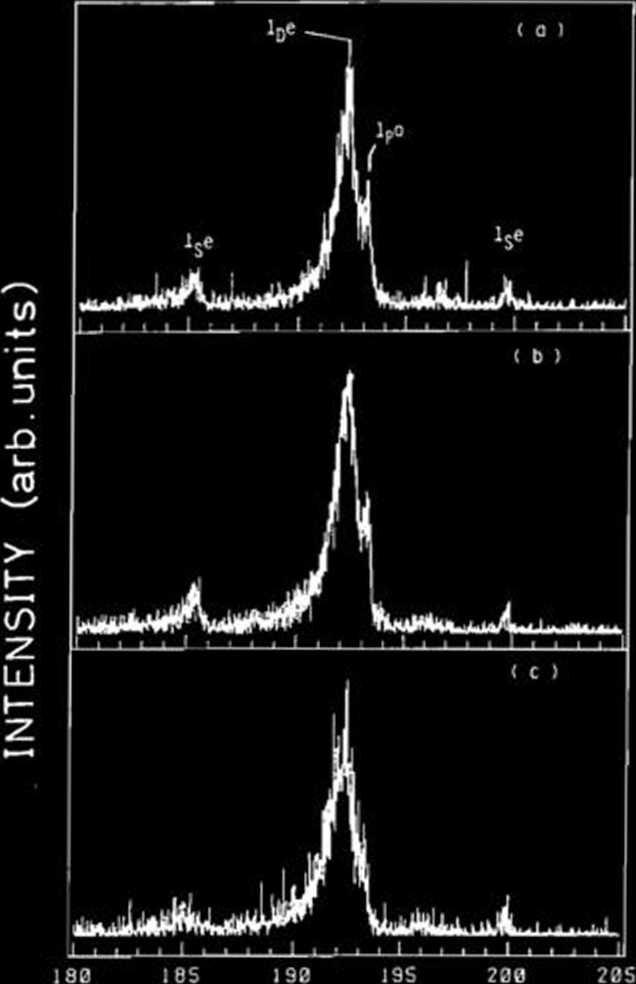372596241
56
RIKEN Accel. Próg. Rep. 24 (1990)
111-2-22. Electron Spectra from Doubly Excited Boroń lons
Produced by Double Electron Capture
H.A. Sakaue, Y. Kanai, T. Nabeshima, N. Nakamura, I. Yamada,* S. Ohtani, K. Wakiya, H. Suzuki, T. Takayanagi, T. Kambara,
A. Danjo, M. Yoshino, and Y. Awaya

224 226 228 230 232 234
Fig. 2. High resolution ejected electron spectra from the 2/3/' configuration of B3+. Each peak is tentatively identified as shown. Collision energy is (a) 65 keV; (b) 50 keV; and (c) 37.5 keV.
We measured spectra of electrons ejected by the following double-electron transfer collisions at varying collision energies (37.5, 50, and 65 keV);
B5+ + He(ls2) —>B3+(2/n/') lL + He2*
UB4+(ls)+e“.
nB5+ ions were produced with the ECRIS (Electron Cyclotron Resonance łon Source) construct-ed as an ion source for the RIKEN AVF cyclotron. Spectra of ejected electrons were measured by zero-degree electron spectroscopyT

ELECTRON ENERGY (eV)
Fig. 1. High resolution ejected electron spectra from the 2121' configuration of B3+. Each peak is tentatively identified as shown. Collision energy is (a) 65 keV; (b) 50 keV; and (c) 37.5 keV.
High resolution spectra of ejected electrons from 2/2/' and 2/3/' States are shown in Figs. 1 and 2, respectively. We tentatively identify each peak as denoted in the figures. The relative-intensity ratio of the peaks in 2/2/' does not change with collision energy, but that of the
ELECTRON ENERGY (eV)
peaks in 2/3/' changes. Possible explanations for this phenomena are (1) the position of the reac-tion window changes with collision energy and (2) the magnetic sublevel distribution mi of each angular momentum State (L) produced by double electron capture changes with collision energy.l)
Since the observed electron peaks are shifted by a post collision interaction (PCI) effect, so we cannot directly compare the observed peak energies with theoretical values. Precise analysis is in progress.
References
1) H.A. Sakaue, Y. Kanai, Y. Ohta, K. Kushima, M. Inaba, S. Ohtani, K. Wakiya, H. Suzuki, T. Takayanagi, T. Kambara, A. Danjo, M. Yoshino, and Y. Awaya: J. Phys., B23, L401 (1990).
*
National Institute for Fusion Science.
Wyszukiwarka
Podobne podstrony:
56 RIKEN Accel. Próg. Rep. 24 (1990)111-2-22. Electron Spectra from Doubly Excited Boroń lonsProduce
81 RIKEN Accel. Próg. Rep. 24 (1990)111-3-17. Hydrogen Desorption from Diamond-like Carbon Film duri
92 RIKEN Accel. Próg. Rep. 24 (1990)111-5. Instrumentation1. Design of a Microbeamline for a Compact
94 RIKEN Accel. Próg. Rep. 24 (1990)111-5-2. Design of a Decay Muon Channel Using an Axially Symmetr
102 RIKEN Accel Próg. Rep. 24 (1990)111-5-8. Performance of Isotopic Separation in RIPS T.Nakamura,
103 RIKEN Accel. Próg. Rep. 24 (1990)111-5-9. Test Experiment of the GARIS/IGISOL K. Morita, T. Nomu
105 RIKEN Accel. Próg. Rep. 24 (1990)111-5-10. Velocity Distribution of IGISOL lon Beams M. Koizumi,
108 RIKEN Accel. Próg. Rep. 24 (1990)111-5-12. Status Report of the RIKEN Swinger-Magnetic Analyzer
110 RIKEN Accel. Próg. Rep. 24 (1990)111-5-14. Test for Dispersive-Mode Beam Transportto the SMART
116 RIKEN Accel. Próg. Rep. 24 (1990)111-5-19. Responses of Large Position-Sensitive Detectorsto Hea
RIKEN Accel. Próg. Rep. 24 (1990)111-5-25. High Speed Serial Data Link for PC-9801 J. Fujita > PC
11 RIKEN Accel. Próg. Rep. 24 (1990)111-1-2. Three a Disintegration of 12C in the Field of208Pb Nucl
12 RIKEN Accel. Próg. Rep. 24 (1990)111-1-3. Coulomb Breakup Reaction of 90 MeV/u 140 T. Takei, T. M
29 RIKEN Accel. Próg. Rep. 24 (1990)111-1-19. Dissociation Cross Sections of nLiK. Soutome, S. Yamaj
RIKEN Accel. Próg. Rep. 24 (1990)111-1-20. Induced Fission Studied with a Multi-DimensionalLangevin
48 RIKEN Accel. Próg. Rep. 24 (1990)111-2-15. High Resolution L X-Ray Angular Distribution Measureme
63 RIKEN Accel. Próg. Rep. 24 (1990)111-2-28. Development of Nuclear Track Microfilters N. Nakanishi
72 RIKEN Accel. Próg. Rep. 24 (1990)111*3-8. Dry Separation of Radioactive Nuclides from a Gold Targ
więcej podobnych podstron